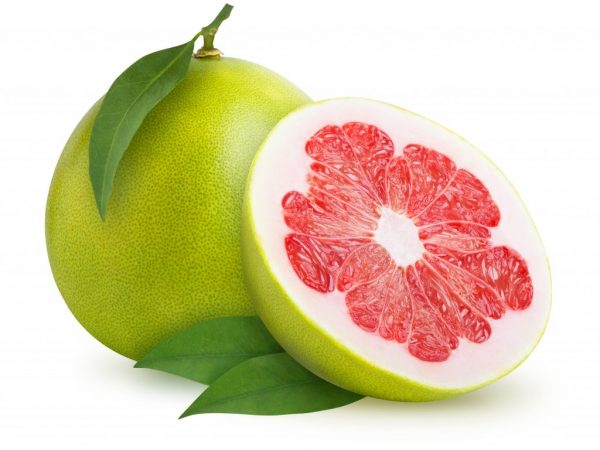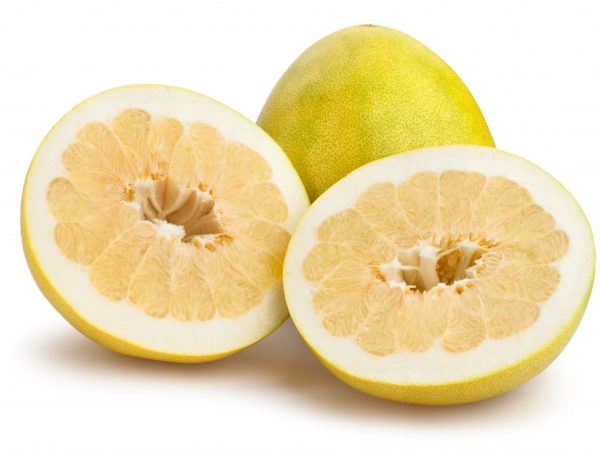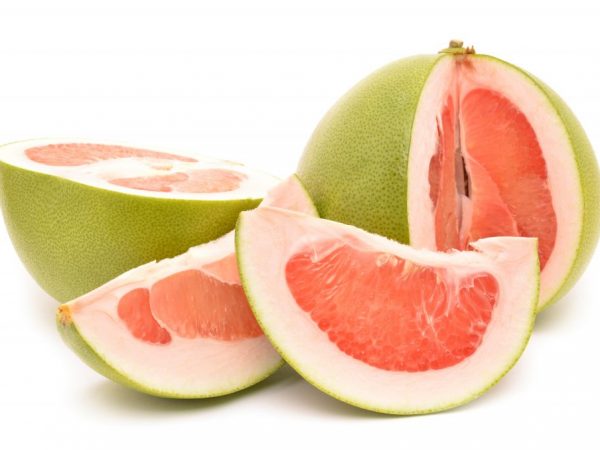Exotic pomelo fruit
The pomelo fruit belongs to the Rutov family, the Citrus family. Its fruits are the largest of all members of the family. It grows in hot tropical countries. It appeared in supermarkets in Russia not so long ago, because people are little familiar with the fruit, they often confuse it with grapefruit.

Exotic pomelo fruit
Origin
The homeland of the pomelo is the southeast Asian countries, or rather, Malaysia and China. From there it spread to India, Fiji, Tonga, Indonesia, Vietnam. Citrus has been known in this area for over 2000 years. There is a misconception that this is a hybrid variety of grapefruit. In fact, grapefruit is a cross between an orange and a pomelo.
In Europe, a large citrus appeared in the XIV century, it was brought by Portuguese and then Dutch sailors. He did not receive wide distribution then. He came to the Old World again from America. It was brought to this continent by the British captain Sheddock in the 17th century, then it became famous in England. In honor of the navigator, the citrus was named "sheddock". In different cultures it is called “big citron”, “bloated lemon”, “apple-melon”, “Pamela”.
Description of the tree
The pomelo is an evergreen tree, it grows up to 15 m. The crown has the shape of a dome or a ball, compactly folded, branches cover with long thorns. The leaves are large and elongated, ovoid. The color of the leaf is dark green, the shade is slightly lighter below. The surface is smooth, but there is a slight edge on the lower part. The plate is 10-20 cm long and sits on a thickened heart-winged petiole.
The pomelo has a medium-sized flower with a diameter of 3-7 cm. They look like six-pointed white stars. Flowers grow singly or gather in 6-10 thyroid inflorescences. Flowering repeats several times throughout the season, the trees are harvested up to 4 times a year, although the main harvesting season is February and March.
The tree grows in the tropical zone, where the average air temperature is 25 ° C-30 ° C. It loves light sandy soils with a high salt content. In some countries, the soil is specially watered with seawater or trenches are dug to the coast so that it flows at high tide.
This type of citrus is grown in Indonesia, Thailand, India, China, Malaysia, Fiji, the USA (Florida and California), and the Caribbean islands. In many countries, it is of great agricultural importance.
Description of the fetus
The fruit of the fruit is a bit like a grapefruit, but surpasses it in size. The weight sometimes reaches 10 kg, and the diameter is 30 cm.In our stores you will not find such giants, but even here the fruits weigh more than 1 kg, their diameter is 15-20 cm.
According to the description, the shape of the fruit is round, sometimes pear-shaped. From above, it is covered with a thick skin with a loose white inner layer, clearly visible on the cut. The color of the peel of ripe citrus itself is from light green to yellow or pink-yellow. The side facing the sun is colored more intensely.
Inside the berry is divided into slices, the partitions between them are thick and bitter in taste. The pomelo pulp consists of many elongated sacs filled with juice. Its color is yellow or red, depending on the variety. There are several seeds inside each wedge. Unlike other citrus fruits, the ripe fruit is not so juicy, it can be bitter or tart.
Fruit composition

Fruit is good for the body
Pomelo, or in other words pamela, has a rich composition. It includes (per 100 g of product):
- proteins - 0.5-0.8 g;
- fats - 0.1-0.3 g;
- carbohydrates - 8.2-8.6 g;
- fiber - 0.4-0.8 g;
- ash - 0.4-0.7 g;
- dry matter - 7.6-11.1 g;
- water - 88.5 g.
The calorie content of the fruit is only 38 kcal per 100 g.
In addition to the basic substances, citrus contains many minerals. It contains a lot of potassium, phosphorus, magnesium, calcium, iron. The pulp is rich in vitamins: it contains B vitamins (thiamine, riboflavin, biotin), beta-carotene, ascorbic and folic acid (vitamins C and B9). The skins and core contain esters, limonoids, ethacrynic and other organic acids.
Useful properties of pomelo
The healing properties of citrus fruit have been known in history for a long time. In China and other countries, it was used to treat colds, asthma, and heart disease. The healing effect was so strong that over time, the pomelo became sacred, it was brought as a gift to the gods. Until now, large rounded fruits are used in many religious ceremonies in Hindu temples.
Pamelo has a low calorie content, and the high sugar content helps to quickly satisfy hunger. It is included in weight loss diets. Fiber regulates bowel function, enzymes speed up fat metabolism, which also contributes to weight loss. The pulp contains a lot of calcium, so eating the fruit is advised for diseases of bones and joints.
Essential oils, vitamin C and other substances make the body more resistant to infections, help fight viruses, and improve the immune response. Esters have a beneficial effect on the nervous system, soothe and relieve stress. Lemonoids prevent cancer from occurring and even help destroy existing tumors. They have a good effect on vision, reduce the symptoms of cataracts. The fruit replenishes the supply of vitamins, especially in late winter or early spring.
Juice and pulp reduce blood pressure, regulate cholesterol metabolism, prevent atherosclerosis and blood clots. Citrus also helps with bronchial asthma, relieves cough symptoms, relieves intestinal infections, relieves intoxication, cramps and abdominal pain. Citrus fruit is also recommended for alcohol poisoning. It is said to regulate the production of female sex hormones and the menstrual cycle.
People with citrus allergies should not eat the fruit. Patients with diabetes mellitus use it with caution, you need to monitor the level of glucose in the blood. Pomelo is not recommended during an exacerbation of an ulcer or in acute gastritis, enteritis, so as not to irritate the gastrointestinal mucosa. You should also limit the consumption of citrus to lactating women so that the baby does not have an allergic reaction.
Pomelo varieties

To date, several varieties have been bred, which differ in appearance, taste, yield. There are even varieties that are home grown. True, their fruits are small and tasteless: the fruit of tropical origin does not ripen in temperate climates. It takes a lot of effort to get them.
The main varieties of pomelo:
- Khao horn. The skin is yellow-green, the middle is light, almost white, the taste of the pomelo is sweet, after the final ripening the bitterness is not felt.
- Khao namphung. The shape of the fruit is pear-shaped, the peel is green-yellow, the flesh is white-yellow, sweet.
- Thai variety Khao paen. In shape, the fruit resembles a ball, flattened from the poles, the skin is green-yellow, 1-2 cm thick, becomes slightly wrinkled during storage. Pomelo is a sweet and sour fruit with a slight, barely noticeable bitterness.
- Khao phuang from Bangkok.The shape is pear-shaped and elongated, the diameter is about 12 cm. The peel is up to 2 cm thick, green-yellow, smooth. The pulp is juicy, sweet and sour, without bitterness and seeds.
- Large spherical fruit with a diameter of 15 cm. The peel is thin, up to 1 cm thick. The pulp is pink, juicy and sweet, without bitterness, a lot of seeds.
- An early variety with a high nutrient content. The tree blooms in autumn, and bears fruit in late December or early January. The peel is light green, the edible center is white-yellow, sweet.
- The variety comes from the eponymous island of Timor. Large fruits grow on small trees, their skin is yellow, the soft part is yellow-pink.
- Large citrus with a yellow peel, rounded. The pulp is harsh, yellow-orange, sweet. This variety is recommended for home cultivation.
On the basis of the pomelo, various hybrids are derived. For example, by crossing a white grapefruit with this citrus, they got the fruit oroblanco, or grind. Oroblanco is similar in appearance to a grapefruit, but it has a thicker skin and a pronounced bitterness. A hybrid of Israeli grapefruit with pomelo is called sweetti. This fruit has a thick, bitter rind that is used to make candied fruits. The pulp is juicy and sweet, without bitterness and seeds.
How to eat and choose pomelo correctly
People have been eating oranges, tangerines, lemons, and even grapefruits for decades. But pamela is a fruit that is relatively new in our area, therefore not everyone knows how to choose it correctly in the store.
Some helpful tips:
- The citrus scent should be felt even from a distance. If you took the fruit in your hand, sniffed it and did not smell it, leave it on the supermarket shelf.
- Use fruits with evenly colored skins. It can be light green, yellow, or with a slight pink tint.
- To the touch, the peel should be dense, elastic, you cannot buy a pomelo with areas of softening or compaction. In the first case, it is most likely rot. In the second, defects caused by improper cultivation or storage. The pulp of such fruits is tasteless and dry.
- Red or brown spots, streaks are a sign of plant disease, which affects the taste.
We traditionally eat pomelo raw. First, the thick rind is cut, then the fruit is divided into slices. It is advisable to peel thin skins, they are bitter. In Asian countries, citrus is added to salads, even fish and meat. It is served with meat dishes, they say that it turns out so delicious. The food has a contrast between sweet and sour and salty.
Before lunch in Vietnam, pomelo baskets are served as an aperitif. In some national cuisines, this citrus is prepared as a vegetable. It is fried in palm oil or added to soups. Candied fruits are often made from the thick peel of fruits: they are covered with sugar, poured with syrup or dry processed. They are sweet, with a pungent bitterness and strong citrus aroma. Candied fruits are added to desserts or salty dishes.
The pomelo fruit has found its application in cosmetology and aromatherapy. The peel contains many essential oils. They are extracted and added to aromatic oils, perfumes and other cosmetics. Good anti-aging masks are obtained from the pulp, which improve the complexion, make it smooth and elastic. You need to take 100 g of pulp, add a spoonful of honey and lemon to it, put it on your face and keep it for a quarter of an hour.
Summarizing
Everything interesting about the pomelo is mainly related to its origin and use in cooking. The sales season starts in January and lasts until April. In other months, citrus is also brought to some supermarkets. True, the prices for it are higher at this time.


